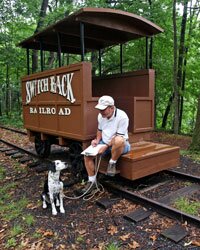|
||||||
The Switchback inspires a forester/poet who loves history“I’m excited about the fascinating history of the Switchback,” said Jeff Wartluft of Lehighton. “It made me want to write a poem.” “I would have loved to have ridden the Switchback Gravity Railroad when it was operating, but obviously, I can’t do that now,” he continued. Wartluft is currently Treasurer of the Switchback Gravity Railroad Foundation. Wartluft noted that the Foundation has worked for many years to keep alive America’s first significant railroad that was created in 1827 to link the Great Coal Mine in Summit Hill to the Lehigh River Navigation System at Mauch Chunk, current Jim Thorpe. The Switchback, actually a nickname for the Mauch Chunk and Summit Hill Railroad that later used switchbacks to descend into the Panther Valley mines, ran for over a century until it was sold for scrap during the Depression. From its beginnings, the Switchback served as both a coal transport railroad—the first in the nation—but also as a tourist railroad. People marveled at this downhill-by-gravity railroad reaching speeds of nearly 50 mph for hour before discharging at Mauch Chunk and then, being pulled back uphill by a team of mules. In 1843, steam engines were located on the summits of Mount Pisgah and Mount Jefferson to pull the empty cars to the top of the mountain where they could return to the mine by a system that is credited with being the first roller coaster in the US. In 1873, the Switchback ceased coal operations and concentrated on becoming the most popular made-made tourist destination in America. Since its formation, the Foundation has helped maintain the Switchback right-of-way as a trail, worked to reduce erosion on the Mount Pisgah Plane, placed interpretive signs, and issued books and videos. The Foundation is currently working with the National Park Service and the Delaware & Lehigh National Heritage Corridor in a feasibility study of the Mount Pisgah Plane—where the remains of the Engine House, cistern and trestle foundations are still visible. Wartluft, a consulting forester, canoeist and outdoorsman, began writing light poetry in 2000 while on a schooner trip in Penobscot Bay, Maine. “I enjoyed the trip, and while we were on board, I wrote the poem,” he said. “The last night when we got together to tell jokes and sing, I read the poem and everyone thought it was really neat.” Since then, Wartluft has written poems to celebrate graduations and for dinner meetings of his paddling group, the Lehigh Valley Canoe Club He is especially drawn to the Switchback because of its history and “knowing that it went through the woods makes it extra nice.” For more information about the Foundation, see HYPERLINK "https://switchbackgravityrr.org" switchbackgravityrr.org, or call: 570-325-8255. ---------- Switchback Fever
|
||||||
